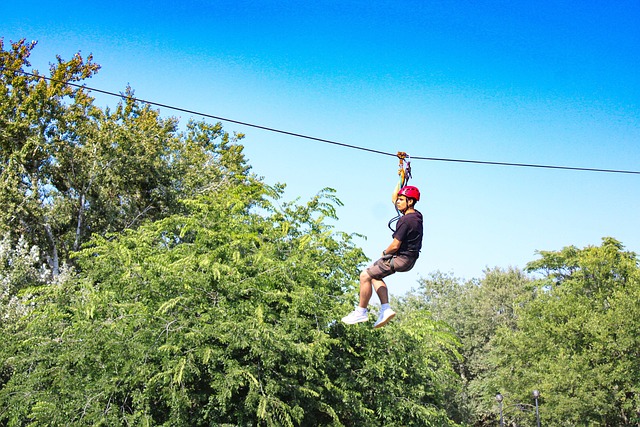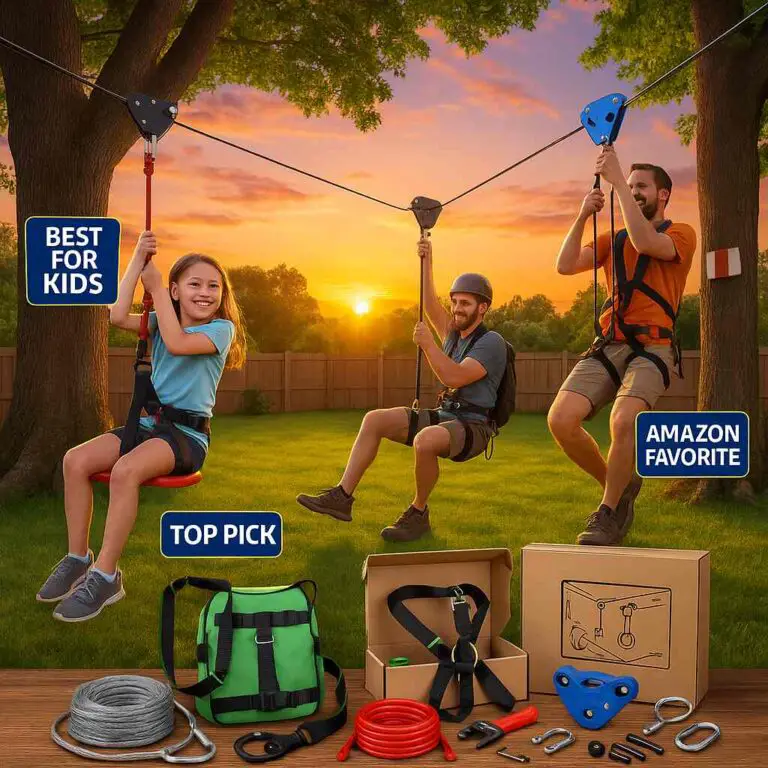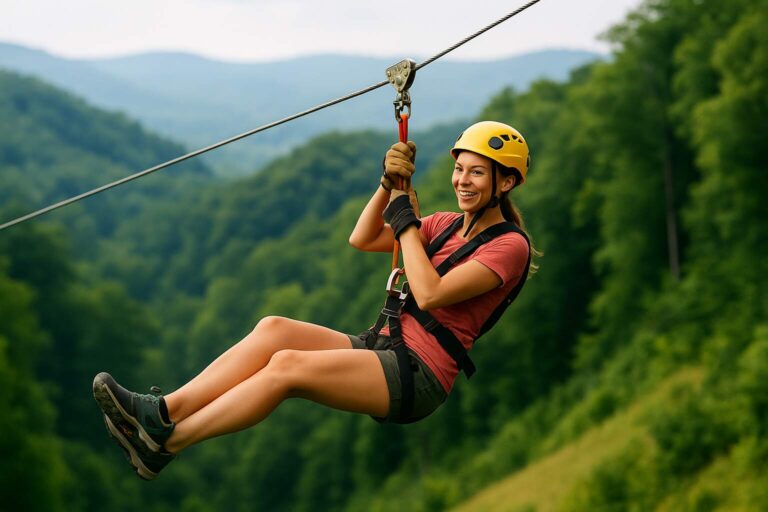Ziplining is a thrilling adventure activity that involves riding a cable from one point to another while suspended in the air. While ziplining can be an exhilarating experience, it’s important to understand the potential risks involved, including the risk of hurting your back.
Ziplining can potentially cause back pain, especially if the rider has existing back injuries or conditions. The repetitive motion of ziplining can put a strain on the back muscles and spine, and maintaining a certain position for an extended period of time can also contribute to back pain.
However, not everyone will experience back pain while ziplining. Factors such as the length of the ride, the steepness of the cable, and the rider’s physical fitness and posture can all play a role in whether or not ziplining will cause back pain.
In this article, I will explore the mechanics of ziplining, the potential risks associated with the activity, and most importantly, answer the question in detail on whether or not ziplining can hurt your back. I’ll also provide tips on how to prepare for your ziplining adventure to minimize the risk of injury and ensure a safe and enjoyable experience.
How ziplining works?
Ziplining involves riding a cable from one point to another while suspended in the air. The cable is typically anchored between two high points, such as trees, poles, or towers. Riders wear a harness that is connected to the cable using a pulley, which allows them to slide along the cable.
To begin a zipline ride, riders usually climb a ladder or stairs to a platform located at the top of a high point. Once they reach the platform, they are connected to the zipline cable using a harness and a pulley system. Riders then step off the platform and gravity takes over, propelling them along the cable at high speeds. Riders typically come to a stop at the end of the zipline using a braking system or a guide.
The speed and distance of a zipline ride can vary depending on the length and steepness of the cable, as well as the weight and size of the rider. Ziplining can be a thrilling experience, but it’s important to understand the mechanics of the activity to ensure your safety.
Potential risks of ziplining
Like any adventure activity, ziplining has potential risks that riders should be aware of. Here are some of the potential risks associated with ziplining:
- Falls – Falling from a zipline can result in serious injury or even death. It’s important to follow all safety rules and regulations, including wearing proper safety gear and staying within designated areas.
- Collisions – Colliding with another rider or an obstacle while on the zipline can result in injury.
- Equipment failure – Faulty or improperly maintained equipment can lead to equipment failure and result in injury.
- Back pain – The repetitive motion of ziplining can cause strain on the back, especially if the rider has existing back injuries.
- Weather conditions – Adverse weather conditions such as high winds, lightning, or heavy rain can make ziplining unsafe and increase the risk of injury.
It’s important to follow all safety rules and regulations, wears proper safety gear, and be aware of your surroundings to minimize the risk of injury while ziplining.
Physical risks such as back pain
One of the physical risks associated with ziplining is back pain. The repetitive motion of ziplining can cause strain on the back, especially if the rider has existing back injuries or conditions.
During a zipline ride, riders are suspended in the air and often required to maintain a certain position for an extended period. This can put a significant amount of strain on the back muscles and spine, especially if the rider is not used to this type of physical activity.
Riders who have existing back injuries or conditions such as herniated discs or spinal stenosis may be at a higher risk of experiencing back pain while ziplining. The high speeds and sudden stops of a zipline ride can also exacerbate existing back conditions.
To minimize the risk of back pain while ziplining, riders should ensure that they are physically prepared for the activity. This may include stretching before the ride, building up core strength, and maintaining proper posture while on the zipline.
Riders who have existing back injuries or conditions should consult with a healthcare provider before participating in ziplining or any other physical activity to determine whether it is safe for them to do so. It’s important to prioritize your safety and well-being when participating in adventure activities like ziplining.
Safety precautions and regulations
There are several safety precautions and regulations that zipline operators must follow to ensure the safety of riders. These precautions may include:
- Safety gear – Riders are typically required to wear a harness, helmet, and other safety gear such as gloves and closed-toe shoes.
- Weight limits – Zipline operators may impose weight limits to ensure that the cable and equipment can safely support riders.
- Braking systems – Zipline operators may use various types of braking systems, such as automatic or manual brakes, to slow down or stop riders at the end of the ride.
- Inspections and maintenance – Zipline equipment should be regularly inspected and maintained to ensure that it is in good condition and functioning properly.
- Weather conditions – Zipline operators may cancel rides or temporarily close due to adverse weather conditions such as high winds or lightning.
- Training and supervision – Zipline operators may provide training and supervision to ensure that riders understand the safety rules and regulations and are properly using the equipment.
Riders need to follow all safety rules and regulations while ziplining to minimize the risk of injury. Before participating in a zipline ride, make sure to ask the operator about their safety procedures and regulations. If you notice any safety concerns while on the ride, speak up and alert the operator immediately.
Does ziplining hurt your back?
Ziplining can potentially cause back pain, especially if the rider has existing back injuries or conditions. The repetitive motion of ziplining can put a strain on the back muscles and spine, especially if the rider is required to maintain a certain position for an extended period of time.
However, not everyone will experience back pain while ziplining. Factors such as the length of the ride, the steepness of the cable, and the rider’s physical fitness and posture can all play a role in whether or not ziplining will cause back pain.
To minimize the risk of back pain while ziplining, riders can take several steps such as stretching before the ride, building up core strength, maintaining proper posture, and consulting with a healthcare provider if they have existing back injuries or conditions.
Overall, while ziplining can potentially cause back pain, it’s important to remember that the activity can be safe and enjoyable if proper safety precautions are followed, and riders are physically and mentally prepared.
Factors that can contribute to back pain during ziplining
Several factors can contribute to back pain during ziplining. These include:
- Repetitive motion – The repetitive motion of sliding along the zipline cable can put a strain on the back muscles and spine, especially if the rider is required to maintain a certain position for an extended period of time.
- Lack of physical fitness – Riders who are not physically fit may experience more strain on their back muscles while ziplining.
- Poor posture – Poor posture while on the zipline, such as slouching or leaning too far forward or backward, can put additional strain on the back muscles and spine.
- Existing back injuries or conditions – Riders who have existing back injuries or conditions such as herniated discs or spinal stenosis may be at a higher risk of experiencing back pain while ziplining.
- Improper equipment – Equipment that does not fit properly or is not adjusted correctly can put unnecessary strain on the back muscles and spine.
To minimize the risk of back pain during ziplining, riders should ensure that they are physically prepared for the activity and that their equipment fits properly and is adjusted correctly. They should also maintain proper posture while on the zipline and take breaks as needed to avoid overexertion. If a rider experiences any discomfort or pain during the ride, they should immediately alert the zipline operator and seek medical attention if necessary.
Possible impact on existing back injuries
Ziplining can potentially exacerbate existing back injuries or conditions. The high speeds and sudden stops of a zipline ride can put additional strain on the back muscles and spine, which can worsen existing injuries or conditions such as herniated discs or spinal stenosis.
If a rider has existing back injuries or conditions, it’s important to consult with a healthcare provider before participating in ziplining or any other physical activity to determine whether it is safe for them to do so. In some cases, a healthcare provider may recommend that a rider avoid ziplining or take extra precautions to protect their back.
Riders with existing back injuries or conditions should also ensure that their equipment fits properly and is adjusted correctly to minimize the risk of further injury. They should also maintain proper posture while on the zipline and take breaks as needed to avoid overexertion.
Overall, riders with existing back injuries or conditions should approach ziplining with caution and prioritize their safety and well-being. If a rider experiences any discomfort or pain during the ride, they should immediately alert the zipline operator and seek medical attention if necessary.
Tips for preventing back pain while ziplining
Here are some tips for preventing back pain while ziplining:
- Stretching – Before the ride, take some time to stretch your back muscles and warm up your body.
- Building core strength – Building up your core strength through exercises such as planks or crunches can help support your back muscles while ziplining.
- Proper posture – Maintain proper posture while on the zipline, keeping your back straight and shoulders relaxed.
- Taking breaks – If you start to feel discomfort or pain in your back, take a break and stretch before continuing the ride.
- Consulting with a healthcare provider – If you have existing back injuries or conditions, consult with a healthcare provider before participating in ziplining to determine whether it is safe for you to do so.
- Choosing the right equipment – Ensure that your equipment fits properly and is adjusted correctly to minimize the risk of strain on your back muscles.
By following these tips, you can minimize the risk of back pain while ziplining and enjoy a safe and enjoyable experience.
How to prepare for ziplining
Here are some tips for preparing for a ziplining adventure:
- Research the zipline company – Choose a reputable zipline company that prioritizes safety and regularly inspects their equipment.
- Dress appropriately – Wear comfortable, weather-appropriate clothing, and closed-toe shoes. Avoid wearing loose clothing that could get caught in the zipline.
- Hydrate and eat a light meal – Drink plenty of water before the ride to stay hydrated, and eat a light meal to avoid feeling too full or bloated.
- Physical preparation – Ensure that you are physically prepared for the activity by building up your core strength through exercises such as planks or crunches, and stretching before the ride.
- Mental preparation – Prepare yourself mentally for the activity by familiarizing yourself with the safety rules and regulations, and visualizing a safe and enjoyable ride.
- Follow instructions – Listen carefully to the zipline operator’s instructions and follow all safety rules and regulations.
Here are the zipline dos and don’ts for more detail.
Conclusion
Ziplining can be an exhilarating adventure activity, but it’s important to understand the potential risks involved and take necessary precautions to ensure your safety. While ziplining can potentially cause back pain and other injuries, proper preparation, and adherence to safety rules and regulations can minimize the risk of injury.
To prepare for a ziplining adventure, it’s important to research the zipline company, dress appropriately, hydrate and eat a light meal, and ensure that you are physically and mentally prepared for the activity. During the ride, maintain proper posture, take breaks as needed, and alert the zipline operator if you experience any discomfort or pain.
By following these tips, riders can enjoy a safe and enjoyable ziplining experience while minimizing the risk of injury. Remember to prioritize your safety and well-being, and always consult with a healthcare provider before participating in ziplining or any other physical activity if you have existing injuries or conditions.








